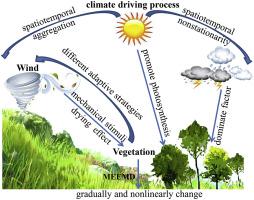当前位置:
X-MOL 学术
›
Remote Sens. Environ.
›
论文详情
Our official English website, www.x-mol.net, welcomes your
feedback! (Note: you will need to create a separate account there.)
Evolution of NDVI secular trends and responses to climate change: A perspective from nonlinearity and nonstationarity characteristics
Remote Sensing of Environment ( IF 11.1 ) Pub Date : 2021-03-01 , DOI: 10.1016/j.rse.2020.112247 Liqin Yang , Qingyu Guan , Jinkuo Lin , Jing Tian , Zhe Tan , Huichun Li
Remote Sensing of Environment ( IF 11.1 ) Pub Date : 2021-03-01 , DOI: 10.1016/j.rse.2020.112247 Liqin Yang , Qingyu Guan , Jinkuo Lin , Jing Tian , Zhe Tan , Huichun Li

|
Abstract The evolution of vegetation patterns plays a crucial role in monitoring ecosystem dynamics in face of global warming. Notably, the time-series vegetation trends vary unevenly over time. However, conventional linear methods based on the stationarity assumption, cannot detect the implicit characteristics of nonlinear and gradual vegetation changes. Meanwhile, characterizing the inherent features of nonlinearity and nonstationarity of climatic drivers remains a challenge. This study applied multidimensional ensemble empirical mode decomposition (MEEMD) and Breaks For Additive Seasonal and Trend (BFAST) algorithm to diagnose spatiotemporal evolution and abrupt change in vegetation secular trends based on normalized difference vegetation index (NDVI) data of the Hexi Corridor during 1982–2015. Geographically and temporally weighted regression (GTWR) was used to address the spatiotemporal nonlinearity and nonstationarity of climatic drivers. A wide range of browning trends gradually evolved into greening trends from 1982 to 2015. Compared with ordinary least squares regression, MEEMD could adaptively decompose short-term trends of noise and seasonality and elucidate the entire evolutionary process of NDVI trends. Browning trends prevailed before abrupt changes, and greening trends widely expanded after 2006 due to drought before and intense precipitation during this year. GTWR addressed the nonequilibrium effect of the time dimension on climate drivers, and the R-squared achieved 0.86. The response processes between vegetation and climatic drivers showed significant spatiotemporal nonstationarity and aggregation characteristics based on three-dimensional visualization. In addition to the drivers of temperature, precipitation, solar radiation, and potential evapotranspiration, the drying effect and mechanical stimuli of wind speed on vegetation could not be underestimated. This study provides a novel framework to solve nonlinearity and nonstationarity problems related to vegetation trends and their response mechanisms and promotes the application of remote sensing to solve practical problems.
中文翻译:

NDVI 长期趋势的演变和对气候变化的响应:从非线性和非平稳特征的视角
摘要 面对全球变暖,植被格局的演变在监测生态系统动态方面起着至关重要的作用。值得注意的是,时间序列植被趋势随时间变化不均匀。然而,基于平稳性假设的传统线性方法无法检测非线性和渐变植被变化的隐含特征。同时,表征气候驱动因素的非线性和非平稳性的固有特征仍然是一个挑战。本研究应用多维集合经验模态分解(MEEMD)和加性季节性和趋势中断(BFAST)算法,基于1982年河西走廊归一化差异植被指数(NDVI)数据,诊断植被长期趋势的时空演化和突变。 2015 年。地理和时间加权回归 (GTWR) 用于解决气候驱动因素的时空非线性和非平稳性。从 1982 年到 2015 年,广泛的褐变趋势逐渐演变为绿化趋势。与普通最小二乘回归相比,MEEMD 可以自适应地分解噪声和季节性的短期趋势,阐明 NDVI 趋势的整个演变过程。突变前呈褐变趋势,2006年后受干旱和今年强降水影响,绿化趋势大范围扩大。GTWR 解决了时间维度对气候驱动因素的非均衡效应,R 平方达到 0.86。基于三维可视化的植被和气候驱动因素之间的响应过程表现出显着的时空非平稳性和聚集特征。除了温度、降水、太阳辐射和潜在蒸发量的驱动因素外,干燥效应和风速对植被的机械刺激也不容小觑。该研究为解决与植被趋势及其响应机制相关的非线性和非平稳性问题提供了一个新的框架,并促进了遥感在解决实际问题中的应用。
更新日期:2021-03-01
中文翻译:

NDVI 长期趋势的演变和对气候变化的响应:从非线性和非平稳特征的视角
摘要 面对全球变暖,植被格局的演变在监测生态系统动态方面起着至关重要的作用。值得注意的是,时间序列植被趋势随时间变化不均匀。然而,基于平稳性假设的传统线性方法无法检测非线性和渐变植被变化的隐含特征。同时,表征气候驱动因素的非线性和非平稳性的固有特征仍然是一个挑战。本研究应用多维集合经验模态分解(MEEMD)和加性季节性和趋势中断(BFAST)算法,基于1982年河西走廊归一化差异植被指数(NDVI)数据,诊断植被长期趋势的时空演化和突变。 2015 年。地理和时间加权回归 (GTWR) 用于解决气候驱动因素的时空非线性和非平稳性。从 1982 年到 2015 年,广泛的褐变趋势逐渐演变为绿化趋势。与普通最小二乘回归相比,MEEMD 可以自适应地分解噪声和季节性的短期趋势,阐明 NDVI 趋势的整个演变过程。突变前呈褐变趋势,2006年后受干旱和今年强降水影响,绿化趋势大范围扩大。GTWR 解决了时间维度对气候驱动因素的非均衡效应,R 平方达到 0.86。基于三维可视化的植被和气候驱动因素之间的响应过程表现出显着的时空非平稳性和聚集特征。除了温度、降水、太阳辐射和潜在蒸发量的驱动因素外,干燥效应和风速对植被的机械刺激也不容小觑。该研究为解决与植被趋势及其响应机制相关的非线性和非平稳性问题提供了一个新的框架,并促进了遥感在解决实际问题中的应用。











































 京公网安备 11010802027423号
京公网安备 11010802027423号